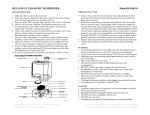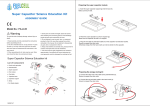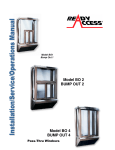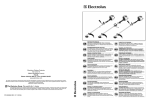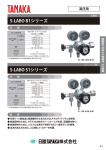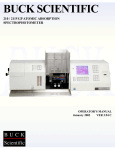Download Fuel Cell Power Pack for 24V Scrubber - Deep Blue
Transcript
Fuel Cell Power Pack for 24V Scrubber Amanda Christiana, Jon Donadee, Matt Garrity, Tim Korhumel Sponsor: Tennant Company Section Instructor: Suman Das ME450 Winter 2007, Team 1 Department of Mechanical Engineering University of Michigan Ann Arbor, MI 48109-2125 Final Report April 13, 2007 ABSTRACT Tennant Company would like to explore the possibility of replacing the deep-cycle leadacid batteries that currently power the commercial T3 scrubber with a fuel cell power pack. Fuel cell technology is being considered in anticipation of reducing environmental impact, improving customer satisfaction by increasing operation time between charging, and simplifying maintenance by eliminating use of lead-acid batteries and the required accessory charger. The deliverables of this project include an assessment of current and future fuel cell technology, a feasibility analysis of a fuel cell system given the current space constraints, quantified price to performance ratios, and a working proof of concept. This report contains the results of our market research, concept generation and evaluation, and selected concepts and final design with engineering, manufacturing, and testing analysis. 1 TABLE OF CONTENTS NOMENCLATURE ...................................................................................................................................... 3 INTRODUCTION ......................................................................................................................................... 3 BACKGROUND INFORMATION.............................................................................................................. 4 TYPES OF FUEL CELLS ............................................................................................................................. 4 ADDITIONAL SYSTEM CONSIDERATIONS .................................................................................................. 5 M ARKET RESEARCH.................................................................................................................................. 6 RETAIL PRODUCTS .................................................................................................................................... 6 SYSTEMS NEAR PRODUCTION .................................................................................................................. 7 HYDROGEN STORAGE ............................................................................................................................... 7 FUEL CELL COMPARISON...................................................................................................................... 7 BALLARD NEXA ......................................................................................................................................... 7 EFOY SMART FUEL CELL ........................................................................................................................ 8 ADAPTIVE M ATERIALS E20 ....................................................................................................................... 8 DESIGN OBJECTIVES .............................................................................................................................. 8 CUSTOMER REQUIREMENTS ..................................................................................................................... 8 ENGINEERING SPECIFICATIONS ................................................................................................................ 9 QUALITY FUNCTION DEPLOYMENT ........................................................................................................... 9 CONCEPT GENERATION....................................................................................................................... 10 FUEL CELL SYSTEM ................................................................................................................................ 11 FUEL STORAGE SYSTEM ......................................................................................................................... 11 ELECTRICAL SYSTEM .............................................................................................................................. 11 CONCEPT EVALUATION........................................................................................................................ 11 FUEL CELL COMPARISON ....................................................................................................................... 11 FUEL STORAGE COMPARISON ................................................................................................................ 12 AUXILIARY BATTERY COMPARISON........................................................................................................ 14 SELECTED CONCEPTS ......................................................................................................................... 15 FUEL CELL SYSTEMS .............................................................................................................................. 16 COMPRESSED FUEL STORAGE ............................................................................................................... 16 TENTATIVE BILL OF MATERIALS AND PRICE LIST .................................................................................. 17 ENGINEERING ANALYSIS..................................................................................................................... 17 HEAT TRANSFER ANALYSIS .................................................................................................................... 17 LIFE CYCLE ANALYSIS ............................................................................................................................ 19 PLANT BALANCE ANALYSIS ................................................................................................................... 21 RISK ASSESSMENT ANALYSIS ................................................................................................................ 21 FINAL DESIGN AND ASSEMBLY ......................................................................................................... 21 LOWER WATER TANK MODIFICATION .................................................................................................... 22 FUEL CELL MOUNTING BRACKETS......................................................................................................... 23 GAS CYLINDER CAGE ............................................................................................................................. 23 HYDROGEN GAS COMPONENT ASSEMBLY............................................................................................. 24 ELECTRICAL COMPONENT ASSEMBLY ................................................................................................... 25 UPPER WATER TANK RISER ................................................................................................................... 25 UPPER WATER TANK BRACKETS ........................................................................................................... 26 FINAL BILL OF MATERIALS ..................................................................................................................... 26 TESTING PLAN......................................................................................................................................... 28 TROUBLESHOOTING ................................................................................................................................ 28 FUTURE WORK ........................................................................................................................................ 29 CONCLUSION ........................................................................................................................................... 30 ACKNOWLEDGEMENTS ........................................................................................................................ 30 REFERENCES........................................................................................................................................... 31 APPENDICES ............................................................................................................................................ 33 APPENDIX A: SUMMARY OF FUEL CELL CHARACTERISTICS ................................................................. 33 APPENDIX B: MEETING WITH SPONSOR ................................................................................................. 34 APPENDIX C: QFD CHART ..................................................................................................................... 35 APPENDIX D: FUEL CELL SYSTEM SPECIFICATIONS ............................................................................. 36 2 APPENDIX E: HYDROGEN STORAGE....................................................................................................... 38 APPENDIX F: POWER DATA FOR THE T3 SCRUBBER ............................................................................ 39 APPENDIX G: PERFORMANCE DATA FOR THE NEXA FUEL CELL SYSTEM ........................................... 40 APPENDIX H: FAILURE MODES AND EFFECTS ANALYSIS........................................................................ 42 APPENDIX I: DC/DC CONVERTER .......................................................................................................... 43 APPENDIX J: ENGINEERING DRAWINGS ................................................................................................. 45 APPENDIX K: DC/DC CONVERTER INSTRUCTIONS ............................................................................... 48 APPENDIX L: GANNT CHART .................................................................................................................. 56 APPENDIX M: BIOGRAPHIES ................................................................................................................... 57 NOMENCLATURE AFC Ah cm DMFC FCV HHV kg kPA kmh kW l LFL m MCFC MEA Assembly PAFC PEM Membrane sl SOFC Alkaline Fuel Cell Ampere Hour Centimeter Direct Methanol Fuel Cell Fuel Cell Vehicle Higher Heating Value Kilogram Kilopascal Kilometers Per Hour Kilowatt Liter Lower Flammability Level Meter Molten Carbonate Fuel Cell Membrane Electrolyte Phosphoric Acid Fuel Cell Polymer Electrolyte Standard Liter Solid Oxide Fuel Cell INTRODUCTION Tennant Company is a leading manufacturer of commercial and industrial floor care machines worldwide. They currently control around 10% of the market with annual revenues in excess of $500 million. In addition to meeting performance standards, Tennant strives to meet ‘green cleaning’ standards. They have developed environmentally friendly products from detergents and coatings to cleaning machines and systems [1]. Deep-cycle lead-acid batteries power their portable scrubbers, including the T3. Battery recycling is well established but there is a risk to the environment if they are not disposed of properly [3]. Lead-acid batteries are 3 inexpensive but recharge time, diminishing capacity, limited life, and environmental stigma have motivated Tennant to examine alternative energy storage. Fuel cell systems offer unique advantages as portable energy storage units compared to lead acid batteries. The major appeal of a fuel cell system stems from its potential to deliver pollution free energy when run on pure hydrogen. A complete fuel cell system could be lighter than the 76 kg pair of batteries that currently power the system making it easier to operate and more efficient. The system could be designed to extend the current run-time of 2.5 hours or at least offer a re-fuel time on the order of a couple of minutes rather than several hours of recharging. The low-noise operation of fuel cells is comparable to battery power, and system maintenance would never put the user in contact with corrosive fluids. As an emerging technology, fuel cell systems present several challenges. In the current stage of development, cost is a major obstacle. Manufacturing processes are both expensive and energy intensive. Existing systems have relatively low volumetric power densities with respect to batteries and combustion engines. This creates a problem for non-stationary applications. Fuel storage and availability are also significant barriers. Gaseous hydrogen storage units are large and heavy. Liquid hydrogen systems are smaller and lighter but require much more energy to maintain cryogenic temperatures. The extent to which these issues will limit integration with the T3 scrubber is to be examined. The purpose of this project is to conduct research and specify a fuel cell suitable for powering Tennant Company’s T3 floor scrubber. We will assemble, debug, and characterize the working prototype. We have researched fuel cell technology, contacted our sponsor from Tennant to understand the company’s requirements, and organized a plan to ensure that we meet our goals. We have generated and evaluated conceptual systems that meet the design specifications. This paper details the results of our research and the system design concepts. BACKGROUND INFORMATION A fuel cell, like a battery, is a galvanic cell that converts chemical energy directly to electrical energy. Galvanic cells generally consist of two electrodes, the anode and cathode, and an electrolyte. The anode is the negative electrode. It is made of a substance that is easily oxidized releasing electrons. The cathode is the positive electrode. It is made of a substance that is easily reduced, absorbing electrons. Together the electrodes create a spontaneous oxidation reduction reaction. An electrolyte is placed between the anode and cathode so the electrons can flow through an external load while allowing the reaction to proceed. In contrast to batteries, a fuel cell converts supplied fuel to electricity as long as reactant gases are supplied. In fuel cells the fuel and oxidant gas comprise the anode and cathode, respectively. Neither the electrodes nor electrolyte are consumed during the course of operation. TYPES OF FUEL CELLS There are six major classes of fuel cells classified primarily by the kind of electrolyte 4 used. The electrolyte determines the chemical reaction, the catalysts required, the operating temperature, the fuel required, and the suitable applications. A summary of the basic information for each type of fuel cell is listed in Appendix A. The operating conditions of the polymer electrolyte membrane fuel cell (PEMFC) make it the most suitable for mobile applications such as Tennant’s T3 Scrubber. The PEMFC has a relatively low operating temperature using highly developed catalysts and electrodes to compensate for the otherwise slow reaction rate. Additionally, there are no corrosive fluids needed for operation and the cell can operate in any orientation. The power output of the PEMFC can be scaled from a couple of watts to tens of kilowatts. The electrolyte is a solid polymer membrane with a catalyst-coated porous electrode bonded and sealed to each side. The most widely used polymer is Dupont’s Nafion. Noble metals such as platinum are often used as the catalyst, but today less expensive alternatives exist. Because the membranes are sensitive to fuel impurities it is important to use pure hydrogen as a fuel for PEM fuel cells. The direct methanol fuel cell (DMFC) is a type of PEMFC that is able to use methanol, directly, in liquid form as opposed to extracting the hydrogen externally. These fuel cells are low power, usually less than 100 W making them most appropriate for applications requiring slow and steady power for long periods of time such as portable electronics. Alkaline fuel cells overcome slow reaction rates by using very porous electrodes and platinum catalysts while operating at high pressure. The operation temperature is usually around 100°C. The fuel and air supply must be free of CO2, which can add to the cost of the system. Alkaline fuel cells are historically used in military and space applications although as price in PEM fuel cells goes down they are becoming less practical. The phosphoric acid fuel cell (PAFC) was the first to be commercially produced in quantities in the US, Europe, and Japan. The reaction rate is relatively high due to the porous electrodes, platinum catalysts, and high operating temperature. Natural gas can be reformed, however carbon dioxide will be a by-product and the equipment adds cost and complexity to the system. Overall the PAFC system tends to be reliable and low maintenance. Large numbers of 200 kW combined heat and power systems (CHP) are currently in use. The solid oxide fuel cell (SOFC) operates at very high temperatures, which eliminates the need for expensive catalysts. Additionally natural gas can be used directly without the need for a separate reformer. The ceramic material used in the cells is expensive and difficult to handle. This system usually requires fuel and air pre-heaters and the cooling process is complex. Furthermore the SOFC system can takes 20 minutes or more to start-up. Notable exceptions include the e20 and e50 portable SOFC from Adaptive Materials, Inc. ADDITIONAL SYSTEM CONSIDERATIONS There are other important considerations that affect the overall efficiency of the system 5 and may vary greatly between applications and designs including: oxygen or air supply, hydrogen supply, water management, heat management, operating pressure, hydrogen storage, and power conditioning. To address these issues additional system components are needed. Air and fuel may need to be circulated through the stack using pumps or blowers. Water content in the electrolyte must be carefully balanced as to maximize the proton conductivity without flooding the pores of the membrane, often requiring external humidification of the oxidant gas before entry to the cell. A separate source of air or water may be needed to remove excess heat produced by the cells. A compressor or regulator and a feedback control system are generally needed to control the pressure within the stack. Hydrogen storage is also an important factor; low-pressure metal hydride tanks can be heavy and expensive while highly compressed hydrogen storage can be energy intensive. Some power conditioning, such as a voltage regulator, will be needed for connection to the electric load. Fuel cell systems are typically installed in parallel with batteries or capacitors to manage load peaks. M ARKET RESEARCH Current estimates predict that the portable power market for fuel cells will be worth $2 billion by 2011, and many companies are already competing for their share of this emerging market. Fuel cell stacks currently available on the market or in the near term are targeting applications such as battery chargers, electrical power sources for soldiers, small electronics, and back up home generation. DMFCs are particularly well suited for small electronics and soldier power units due to space and weight restrictions with a power requirement on the order of tens of watts. Fuel cell powered battery chargers and home generators generally use PEMs on the scale of hundreds of watts up to a few kilowatts. RETAIL PRODUCTS Fuel cells can be purchased as stack components, stacks, and complete systems. Our search was focused on systems near to the T3’s power requirement, around 1 kW. There are several low kW range turn key systems available from companies such as Ballard, ReliOn, Intelligent Energy, Hydrogenics, ECD Ovonics, and Arcotronics to name a few. Most manufacturers’ websites will only provide quotes upon request. Currently there are only a few retail websites, such as www.fuelcellstore.com, selling complete fuel cell systems. These systems come with components for heat and water management, fuel and airflow, and internal control. Five examples of retail systems currently on the market are listed in Table 1. PEM stacks produced in low quantities currently cost approximately $2000/kW but mass produced systems can achieve a price closer to $100/kW [6]. Manufacturers claim that their systems have lifetimes ranging from 1500 hours for the Ballard Nexa [7] to unlimited for the Hydrogenics HyPM [8]. Power Manufacturer System Type of Fuel Cell Ballard Nexa PEM 1200 W ReliOn T-1000 PEM 1200 W ReliOn I-1000 PEM 1000 W Smart Fuel Cell EFOY 1200 DMFC 65 W Adaptive Technologies e50 SOFC 50 W Table 1: Retail fuel cell systems with power outputs of 1.2 kW or less. 6 SYSTEMS NEAR PRODUCTION A number of successful PEMFC demonstrations have been completed ranging from forklifts to radio controlled airplanes. Some of the most advanced PEM systems are being developed for transportation. Honda has announced plans to begin leasing fuel cell vehicles as early as 2008. The cells Honda will use pack 98 kW into a 67 kg and 0.0521 m3 stack and are connected to a Lithium-ion (Li-ion) battery to handle load peaks. This FCV stores 4kg of hydrogen at 34.47 MPa, giving it a range of 569.7 km. This compares to Honda’s first fuel cell system in 1999, which produced 58 kW out of a 202 kg and 0.1339 m3 stack [10]. Another noteworthy product is the ENV motorcycle, which is powered by an Intelligent Energy brand 1kW modular and removable fuel cell CORE system. The CORE is supplemented by four 12 V, 15 Ah lead acid batteries to handle load peaks. The ENV cruises at 80.47 kmph, lasts 4 hours between refueling, and then fuels in minutes. Hydrogen is stored in a high-pressure carbon wrapped cylinder. Most impressively, the ENV motorcycle is set to go on sale in the second half of 2007 for around $6,000 [11]. HYDROGEN STORAGE Currently mobile PEM systems using pure hydrogen rely on one of two storage methods. Either high-pressure cylinders or metal hydride storage cylinders. Metal hydride storage tanks store hydrogen molecules within the molecular matrix of a metal alloy, allowing for low pressure and high storage density per liter. However, cost and weight are greater than high-pressure cylinders, and thermal regulation is required for optimal charge and discharge. In automotive applications hydrogen gas is stored at up to 69 MPa, but this requires significant amounts of energy for compression [12]. A Solid H brand CL-840 metal hydride tank is 11.18 cm in diameter and 25.15 cm long, capable of storing 840 sl at 0.2 MPa, and has a total mass of 5.72 kg. This tank is quoted to cost $1,320, but price varies significantly with specified operating conditions [13]. Hydrogen gas itself can either be bought in compressed gas tanks from an industrial gas supplier, or it can be produced on site by a variety of processes. Water electrolysis and hydrocarbon reforming systems are available from most fuel cell manufacturers. H2Gen Innovations, Inc reports that hydrogen can be produced at fueling stations from natural gas at a price per energy equivalent to gasoline for $1.50[14]. FUEL CELL COMPARISON Background research conducted on this project shows that the field of fuel cell technology is constantly growing. While the Ballard Nexa fuel cell system was selected as the best fit fuel cell to meet the needs of the T3 scrubber it is important to understand that there are other fuel cell options. This section will compare the costs of involved with various fuel cell systems. BALLARD NEXA The Ballard Nexa fuel cell system more than meets the power requirements of the scrubber, producing 1.2 kW. Unfortunately, this power needs to be regulated using a DC/DC converter. The price of the fuel cell comes to $6,500, but in order to provide the proper amount of power to the scrubber the additional cost of the DC/DC converter must be added taking the price of 1 kW of power $9,600. The Nexa system runs using 7 compressed hydrogen which is available at a price of $7.50 for an 80 ft3 cylinder. The expected run time for one cylinder is 243 minutes, making the price per kWh of fuel for the Nexa system $1.83. EFOY SMART FUEL CELL The Smart Fuel Cell (SFC) system from Energy For You (EFOY) is a direct methanol fuel cell system that operates by recharging lead-acid batteries. Since the key to this project is the removal of lead acid batteries from the scrubber, we will consider the power output of the fuel cell bypassing the batteries. A single SFC unit only supplies 65 W which is not sufficient to power the scrubber. In order to reach the needed output two units could be connected in parallel. The cost of two units necessary for reaching 1 kW of power would come to $8,900. The SFC system runs on pure methanol which comes in a 10 liter fuel cartridge. The system uses 1.1 liters of methanol per kWh, with two fuel cells each time the system is refilled with two cartridges it should be able to run for 14 hours. At a cost of $40 per fuel cartridge, each refill of methanol will cost $80, making the cost of fuel $5.71 per kWh. ADAPTIVE M ATERIALS E20 Adaptive Materials’ e20 is a solid oxide fuel cell system. The e20 is a 20 Watt system; this would mean that at least 5 units will be necessary for power the T3 scrubber. With an estimated unit cost of $5,149 this would become the most expensive system at $25,745 per kW. The advantage would come in the cost of fuel for the system. Even running five units simultaneously the cost of propane fuel for one kWh would only be about $0.50. DESIGN OBJECTIVES In order to better understand the core requirements of our project we met with Mr. Fred Hekman from Tennant to establish customer requirements and their relative importance. We then derived quantified engineering specifications and prepared a Quality Function Deployment (QFD) chart. This method helped us identify the major requirements as they relate to our design objectives and determine which fuel cell technologies best fulfill the customer’s need. CUSTOMER REQUIREMENTS When determining our customer requirements the sponsor, Tennant Company, and the end user were considered. We met with our contact at Tennant, Mr. Fred Hekman, and discussed the overall motivation of the project. From our discussion we determined that the focus of the project was to alleviate the environmental concerns of lead-acid batteries, determine the feasibility of a fuel cell based system, show performance beyond that of the current battery-based system, and create a more environmentally friendly image for Tennant. Notes on the first meeting with our sponsor can be found in Appendix A. For environmental considerations, the system needs to be recyclable and free from harmful emissions. From a feasibility standpoint, a fuel cell based system must have an external or working temperature below the melting temperature of the T3’s base materials, it must fit into the current battery’s space, and it should run on a 8 commercially available fuel. The new system needs to run longer between charges, last longer on a single charge, and weigh less than the current batteries. The new system also needs to be safe, easily operated and refueled, and require little maintenance. ENGINEERING SPECIFICATIONS From the customer requirements, we quantified measurable engineering specifications, shown below in Table 2. By achieving these specifications we can determine the success of the project as it progresses. Specification Required Value Operating temperature <40 °C Power Output 1 kw Voltage 24 V Current 30 A 3 Size 0.034 m Additional Components - # Fuel Consumption Rate - L/s Time Between Refuel 3 hrs Weight 76 kg Overall Lifetime >2 yr Table 2: Engineering Specifications QUALITY FUNCTION DEPLOYMENT Once we had determined the requirements and specifications of our design project, we began organizing it into the QFD, Appendix B. The customer requirements were listed in the leftmost column. We then did a direct comparison between each requirement to find their relative importance. While the majority of the requirements focus on improving the performance and usability of the T3 Scrubber, an importance was placed on the safety of the fuel cell powered scrubber from a user and environmental standpoint. Considering that this will be a prototype, some of the requirements that would be more important for a production model were downplayed. For example, as technologies progress and fuel cells become more widely used, lifetime will very likely improve, size and weight will decrease, and more recyclable materials will be put into use. Along with the safety issues, the more important requirements focused on the feasibility of implementing a fuel cell based system (i.e. commercial availability of fuel and meeting current size constraints). The engineering specifications and their units and target values were listed in the middle columns. Each specification was then compared to each other for correlation in the upper “roof” matrix. Values of ++, +, -, --, or blank were filled into this portion to determine the correlation between each specification. We each then compared the specifications to the customer requirements by filling in the central importance matrix with a 0, 1, 3, or 9. These values give a rating of how strong each customer requirement relates to each engineering specification. The individual comparisons were then averaged to give the overall relationships found in the central importance matrix. 9 We then benchmarked several solutions to evaluate how they meet customer requirements (on the right), and listed their current values for each specification (on the bottom). From our evaluation of each benchmark we were able to immediately rule out three of the six different types of fuel cells due to their extremely high operating temperature: Phosphoric Acid Fuel Cells, Solid Oxide Fuel Cells, and Molten Carbonate Fuel Cells. Each of these had operating temperatures well over the 120°C melting temperature of the polyethylene body of the T3 Scrubber. We then determined that a Direct Methanol Fuel Cell would not be able to generate the necessary power to run the scrubber. Finally due to their high expense Alkaline Fuel Cells were ruled out [4, 5, 15]. CONCEPT GENERATION After conducting our market research and meeting with Dr. Chang Kim, we began establishing the necessary components of a fuel cell system that would be required to complete our goal. We came up with a schematic that organized the functionality of the system, Figure 1. Our functional schematic categorizes the required components into three main groups: fuel cell system, fuel storage, and electrical system. We were then able to better organize some of the information we found from our initial research, and better focus our concept generation. Denotes Electrical Path Safety Denotes Fluid Path Ventilation Hood Plumbing Fuel Storage Leak Detector Pressure Regulator Fuel Cell System Fuel System Controller Pressure Regulator Flow Regulator Electrical System Air Compressor Auxillary Battery Temperature Pressure Flow Rate Humidity Sensors 24V DC/DC Converter Ambient Air Humidifier MEA Stack Heat Exhaust Gasses Power to T3 Electrodes Figure 1: Functional schematic of main subsystems. 10 FUEL CELL SYSTEM From our initial research we already determined a few possible solutions for the type of fuel cell needed to complete this project. After talking with several manufacturers (including Ballard, ReliOn, Hydrogenics, and Intelligent Energy) we came up with two potential systems available for purchase that would satisfy the engineering specifications of the project. The Ballard Nexa and ReliOn T-1000 both had comparable electrical outputs to the lead-acid batteries currently being used. We also met with Dr. Chang Kim and discussed the possibility of using a fuel cell stack that the University already owned. This stack was given to Professor Levi Thompson and Dr. Kim after Visteon shut down its fuel cell program in Michigan. While conducting our research we found two other fuel cell technologies available for purchase being used on a smaller scale: Smart Fuel Cell’s EFOY DMFC, and Adaptive Material’s e20 SOFC system. FUEL STORAGE SYSTEM After determining the possible fuel cells that could be implemented for this project, we began brainstorming the actual fuel and storage options that would be required. For the PEM fuel cells that we were considering hydrogen would be necessary. We looked at three main types of hydrogen storage that would be usable: compressed gas H2, metal hydride, and cryogenic (liquid) H2. For the DMFC or SOFC we would need a methanol or propane fuel respectively. ELECTRICAL SYSTEM Other than the Adaptive Materials’ SOFC, the fuel cells we were considering would require some form of an external start up voltage. We held a brainstorming session and came up with various auxiliary power solutions. Along with wall power, the majority of the brainstorming revolved around types of batteries. We decided to look at and compare Nickel metal hydride (Ni-MH), Li-ion, and lead-acid batteries, along with wall power. CONCEPT EVALUATION After researching and generating ideas for a fuel cell powered T3 scrubber, we compared the realistic options for each critical subsystem. A Pugh chart was used to compare the advantages and disadvantages of possible components in a simplified and easy to understand manner. Our previous research allows us to eliminate some of our unrealistic or unavailable concepts before comparing available options. FUEL CELL COMPARISON The Pugh chart for fuel cell system options is shown in Table 3. Ballard’s Nexa System was selected as our datum because it is the most mature and documented option. The Nexa is a fully functional power plant with fully developed electrical, thermal, and fluid control systems. Although it does not match our space and power requirements exactly, Ballard provides good support for product integration. The ReliOn T-1000 fuel cell APU is a complete commercial system with capabilities and performance similar to the Nexa. It also offers modular power capabilities that could remove the need for a DC/DC converter. The T-1000 is designed to be stationary and is therefore larger and heavier 11 than the Nexa, making integration more difficult. DMFC systems use liquid methanol as a hydrogen carrier, offering easy hydrogen storage and refueling. However, the power output of these systems is limited. We considered using multiple DMFC units wired together, but cost and system size would still be prohibitive. A similar concept of wiring multiple Micro SOFC units together was considered. These units use propane as a fuel and were not ready for cost effective production. DMFCs and SOFCs both emit carbon dioxide, creating risks for indoor use. We also considered custom building a fuel cell power system from its more basic elements such as PEM stack, pumps, humidifier, sensors, and control unit. Dr. Chang Kim of the University of Michigan Chemical Engineering department offered to work with us to build a system. The ease of integration and time constraints for this option are restrictive, but a custom made system would allow us to better match power and performance requirements. Based on our research and Pugh chart we have selected the Ballard Nexa and Relion T-1000 as our final options for a fuel cell power plant. The available information, scale of power, and ease of integration for these systems makes them preferable to other commercially available fuel cell systems. We would like to get more information on the T-1000 before making our final decision. Datum Option #1 Option #2 Ballard Nexa PEMFC Relion T-1000 PEMFC DMFC Size 0 - - - + Power Output 0 0 - + - Weight 0 - - - + Temperature Commercial Availability Ease of Use 0 + 0 + 0 0 0 0 0 - 0 + - - - Safety 0 0 - - - Cost 0 - - - - Ease of Integration 0 - - - - Ease of Fueling 0 0 + 0 + Total Points 0 -2 -5 -4 -3 Evaluation Criteria Option #3 Option #4 Build Our Adaptive Own PEMFC Materials System Micro SOFC Table 3: Pugh chart evaluation of fuel cell systems FUEL STORAGE COMPARISON The Pugh chart for fuel storage options is shown in Table 4. After conducting extensive research into the fuel requirements for fuel cells, it was understood that there would be four main fuel storage options. These options include compressed hydrogen gas, methanol, metal hydrides, and liquefied hydrogen. Compressed hydrogen gas was selected as the datum in the Pugh chart below because it is well documented and relatively easy to obtain. 12 Datum Option #1 Option #2 Option # 3 Methanol Metal Hydride Evaluation Criteria Compressed Gas H2 Liquefied H2 Energy/Volume 0 + + + Energy/Weight 0 + - + Commercial Availability 0 0 0 - Ease of Use 0 + - - Safety 0 - + - Cost 0 + - - Flow Rate 0 0 - 0 Total Points 0 3 -2 -2 Table 4: Pugh chart evaluation of fuel storage methods Compressed hydrogen gas is a readily available method of hydrogen storage. Several vendors including Lincoln Composites, Quantum Technology, and Airgas all distribute compressed hydrogen in cylindrical tanks of varying sizes. Compressed gas storage is very common, so the cost of storing hydrogen this way is very reasonable. Using a compressed gas would work well in our system; the gas will easily reach the required flow rate because of the pressure difference caused by compression. Unfortunately, there are several drawbacks to storing hydrogen as a compressed gas. The first of which is that compressed hydrogen stores the smallest amount of energy per volume among our possible options, making it the bulkiest possibility. For a mobile device such as a floor scrubber, this is certainly not ideal. Another stalling point for compressed hydrogen is that because hydrogen is a combustible gas a number of safety precautions must be taken at all times. Not only when the hydrogen is in use, but also while it is being stored. For our application completely leak free piping would have to be tested and used to ensure that there is no hydrogen escaping from our system, and a hydrogen detector will always be necessary. Methanol seems like it may be the most practical way of storing fuel for a fuel cell. Like compressed hydrogen it is readily available. Methanol can store energy at a lower weight and volume than compressed hydrogen. Methanol is also less of a hassle than compressed hydrogen, since it is a liquid it does not need to be under high compression. Although handling liquid methanol is safer than dealing with hydrogen, CO2 emissions can be dangerous indoors. Metal hydrides are an option that initially seemed very promising as a method of fuel containment for our system. Metal hydrides store hydrogen by breaking H2 down into H atoms which can be absorbed into the metal crystal structure. This means that hydrogen is stored with a very high amount of energy per volume. While precautions would still be taken once the hydrogen is released from the tank, the actual storage of 13 hydrogen would be much safer than storing the gas in its pure form. However, there are some major drawbacks to using metal hydrides. They are heavy and require complicated thermal regulation to control charge and discharge flow rates. Refilling procedures are quite time consuming, so there would not be much of an advantage over using batteries that require recharging. In order to reuse a metal hydride tank, a supply of hydrogen would be needed for refilling. This most likely means that compressed hydrogen will still be used, eliminating the gains that metal hydrides provided in safety. Another problem is that many of the metal hydride tanks available would not meet the flow rates needed to power a fuel cell for our power demands. Liquefied hydrogen was the final option we considered for storing fuel for our fuel cell system. The advantages of liquefied hydrogen are that it contains some of the highest energy per volume and energy per weight compared to other options; this would make it a small and light way to contain the fuel for our system. Unfortunately, the liquefaction process requires a large amount of energy, and in order to keep hydrogen in its liquid form it needs to be stored cryogenically at temperatures below -250° C in specially designed storage containers. These problems cause liquefied hydrogen not to be commonly available, and systems that are available come at very high costs. For these reasons it is clearly not practical for our application. While it may seem that methanol would be the obvious choice for our fuel storage based on the results of the Pugh Chart there are disadvantages in DMFCs that prevent them from becoming our fuel cell of choice for this application. Instead we will be using compressed hydrogen option because at this time it is the most feasible way to store hydrogen for a small mobile application. AUXILIARY BATTERY COMPARISON The Pugh chart for auxiliary battery options is shown in Table 5. A sealed lead acid battery (SLA) is used as the datum because this type is currently used as the power source for the T3 scrubber. Sealed acid batteries are a cheap and mature technology, but their weight, safety concerns, and the environmental impact are unappealing. Rechargeable Li-ion and NiMH batteries can both match the performance of SLA batteries with reduced size, weight, and environmental impact [3]. Plugging in the system during startup and shutdown is also an option for providing auxiliary power. An AC/DC converting system would be more complicated to use than a rechargeable battery, but it removes the environmental impact of battery chemicals and their manufacture. A Li-ion battery pack was selected for use as an auxiliary power source because it can meet system requirements in a small and easy to use package with a lower environmental impact. 14 Datum Option #1 Option #2 Option #3 Evaluation Criteria Sealed Lead Acid (SLA) NiMH Li-ion Plug In Size 0 + + + Discharge rate 0 0 0 0 Weight 0 + + 0 Commercial Availability 0 0 0 0 Ease of integration 0 0 0 - Safety 0 + + - Cost 0 - - + Energy Capacity 0 0 0 + Environmental impact 0 + ++ ++ Ease of use 0 + + - Total Points 0 4 5 2 Table 5: Pugh chart evaluation of auxiliary power sources SELECTED CONCEPTS We have combined the results of each subsystem evaluation and generated selected system concepts. The retail PEMFC systems are competitive options for this project in terms of cost, space, and complexity of integration. Ballard’s Nexa is the less expensive, more established option plus it is easily monitored with standard diagnostic software. ReliOn’s T-1000 has longer warranty period and a modular cartridge design that could better match power requirements and potentially eliminate the need for an expensive power conditioner while improving usability. Compressed hydrogen storage was selected mainly for its availability and relative cost. Suppliers such as Lincoln Composites and Quantum Technology offer refillable high pressure fuel tanks while companies like Airgas deliver compressed cylinders filled with hydrogen – industrial to research grade. A Li-ion battery pack will be used for start-up and shut down power requirements because it has the greatest volumetric power density and smallest environmental impact [3]. Composite models of possible system concepts and basic structural modification have been generated as shown in Figure 2. 15 Figure 2a: Three dimension model of Concept A shows relative sizes of T3 Scrubber to the T-1000 1.2 kW fuel cell and the Tuffshell 3300 sl compressed hydrogen fuel tank. Figure 2b: Three dimension model of Concept B shows relative sizes of T3 Scrubber to the Nexa 1.2 kW fuel cell and the AirGas 2265 sl compressed hydrogen fuel tank. FUEL CELL SYSTEMS We need to modify the T3 floor scrubber to accommodate a fuel cell system. A section will be removed from of the body of the scrubber and holes will be made through the opposite side to allow coolant airflow. The Nexa fuel cell stack operates at 65°C and will be exposed to the air inside of the scrubber. Air will exit the stack at approximately 50°C. We will create a duct to direct this air out of the scrubber. A layer of thermal insulation will line the structure of the T3 around the Nexa fuel cell. This heat shield will ensure that the structure stays at or below the working temperature of polyethylene, 40°C. We do not anticipate the T-1000 will require any additional insulation. An auxiliary power source will be required to power each fuel cell system. Based on power requirements listed in the Nexa User Manual we selected a 24V, 5600 mAh Li-ion battery to be used for either system. The unregulated output voltage from the Nexa fuel cell system will require a 1.2 kW DC/DC switching converter for power conditioning to protect the scrubber’s electronics. Many of the operating conditions for the fuel cell systems are the same. Some notable differences are summarized in Table 6 and complete specifications for each system can be found in Appendix D. Fuel Consumption at 1.2 kW Fuel Supply Pressure Weight Dimensions (w x l x h) Warranted Lifetime Nexa <18.5 slpm 0.69 to 17.2 bar 13 kg 25 cm x 56 cm x 33 cm T-1000 < 16.9 slpm 0.24 to 0.41 bar 26 to 54 kg 33 cm x 48 cm x 60 cm 1500 hours or 1 year 3000 hours or 2 years Table 6: Summary of dissimilar characteristics between two competitive 1.2 kW fuel cell systems. COMPRESSED FUEL STORAGE Both compressed hydrogen storage tanks can be mounted to the structure of the scrubber. All protruding components will be kept on one side in the final design. This will ensure that the scrubber will still be able to clean floors near walls. Although a cylinder from Quantum Technology is not shown here, custom designs are available on 16 request. These systems will need additional components that are not shown in the conceptual models. The additional components could include a hydrogen leak detection kit, pressure reducing regulator, braided stainless steel hose assembly, sealed quick connect with shut-off, and manual purge. Most of these are available from Swagelock but we are still waiting for quoted prices. Mounting systems will be required to secure either system to the body of the scrubber. Some characteristics of each system are shown in Table 7. Specifications for Lincoln Composite’s Tuffshell fuel tanks are in Appendix E. Lincoln Composites AirGas Size (OD x L) 24 cm x 46 cm 18 cm x 91 cm Weight 7.1 kg tbd Gas Capacity 3300 sl 2265 sl Pressure 207 bar 138 bar Nexa Run-Time (@ 975 W) 5-4.2 hours 3.4-2.9 hours T-1000 Run-Time (@ 1.2 kW) 3.3 hours 2.2 hours Table 7: Summary of dissimilar characteristics between two compressed hydrogen storage options. TENTATIVE BILL OF MATERIALS AND PRICE LIST Vendors have been contacted for more detailed information. Lead-time for components has generally stated to be about two weeks. A summary of the components needed to implement a system and available prices are shown in Table 8. Component Supplier Price Heliocentris, Nexa 6,500.00 Fuel Cell System ReliOn, T-1000 7,734.00 Air Gas 50.00 Fuel Tank Lincoln Composite tbd DC/DC 1200W Converter Heliocentris 3,100.00 24 V Lithium Ion Battery Pack Battery Space 145.95 Smart Charger Battery Space 34.95 Hydrogen Leak and Detection Kit Fuel Cell Store 860.00 Pressure Reducing Regulator Swagelock tbd Stainless Steel Braided Hose Assembly Swagelock tbd Sealed Quick Connect with Shut-off Swagelock tbd Manual Purge System Swagelock tbd Heat Sheild tbd tbd Fuel Cell Mounting Block tbd tbd Fuel Storage Mounting Brackets tbd tbd Table 8: Bill of materials and price estimate for initial selected concept components. ENGINEERING ANALYSIS The following section outlines our engineering analysis of heat transfer, plant balance, life cycle analysis, and risk assessment. HEAT TRANSFER ANALYSIS In order to determine the appropriate insulation required to protect our scrubber from the heat generated by the fuel cell stack, we performed a thermal analysis of the system. The cell stack could be considered with the following model: 17 Coolant Airflow 1325 W 0.131m Conductive Heat Dissipation 108 W × 3 Sides 0.300m 0.131m Figure 3: Heat Transfer Model of Nexa Fuel Cell Stack. We assumed the front and rear ends of the system to be adiabatic, or insulated, due to the components that cover these portions. The top of the stack includes convective heat transfer from the coolant airflow through the stack. The remaining heat is transferred from the sides and bottom of the stack by conduction through the air to the scrubber body. Before calculating the heat transferred to the body, we had to determine the amount that is lost through the coolant flow that will be ducted away from the scrubber. From the Nexa manual we know the maximum heat power generated by the stack is Ptot = 1650W, and the majority of this is lost in the cool air flow. We also know that the coolant airflow is 3600 slpm when operating at peak power, and that it leaves the stack at a temperature of 17 °C higher than the inlet air (approximately 40 °C when assuming a room , was then calculated: temperature of 22 °C). The mass flow rate, m m = ρ∀ = 1.293 kg m 3 ⋅ 0.06 m 3 s = 0.0776 kg s (1) Where ∀ is the volumetric flow rate, and ρ is the density of air at 40 °C. By assuming an ideal gas with the determined mass flow rate, we could then calculate the heat transfer, q cool in Watts: q cool = m c p ∆T = 0.0776 kg s ⋅ 1.005 kJ kg ⋅ K ⋅ 17 K = 1325W (2) Where c p is the specific heat, and ∆T is the temperature difference between the out flowing coolant air and the ambient. With this we can determine the remaining power left for heat transfer through the sides and bottom of the stack to the scrubber body q cond : q cond = Ptot − q cool = 1650W − 1325W = 325W (3) 18 With each of the three remaining sides of the stack to having approximately the same area A = 0.0393m 3 , we can consider one side with a heat transfer of q cond = 108W . From the Heat Diffusion Equation [16]: qcond = kA dT L (4) Where k is the thermal conductivity of the insulation, L is the thickness of the insulation, and dT is the temperature difference between the sides of the insulation. For this model we assume that the insulation will be in direct contact with the stack and the body of the scrubber. This will over estimate the necessary insulation thickness because there will be some space between the two. From our engineering specifications, page 7, we have a safe scrubber body temperature of 40 °C. Assuming it operates at a uniform temperature throughout, the surface temperature of the stack is approximately 65 °C. Figure 4: Screenshot of CES EduPack showing potential insulation solutions. Using Equation 4 and the CES Edupack we were able to determine possible materials for insulation and their necessary thicknesses. Graphing this against price per area we were able to select the most cost effective solution. LIFE CYCLE ANALYSIS Tennant Company is interested in comparing the environmental impact of using SLA batteries against that of our hydrogen powered design. The electrochemical reaction within Hydrogen fuel cells is much more efficient for creating electricity than combustion. The average efficiency of the total U.S. electrical grid power is near 32%, 19 while our commercially available Nexa fuel cell operates at up to 50% efficiency based on the higher heating value (HHV) of their fuels. Of course, there is a long chain of processes necessary to provide electric power to the T3’s scrub brush by means of hydrogen or the current battery system. Each link in the power supply chain has alternatives and each has an efficiency associated with it. There are many options being considered for future hydrogen production in mass quantities including coal gasification, steam reforming natural gas, or electrolyzing water. The world’s first commercial coal gasification power plant is currently being sited and should be completed by 2011[18]. Due to the currently advanced and near commercial state of coal gasification technologies, we will study a scenario where hydrogen is produced by coal gasification. Figure 5 shows the chain of processes and components that transfer energy to the T3 scrubber for two scenarios. The figure also shows what percent of the original HHV of coal is passed between the components and ultimately to the scrubber. The top path shows the current path that energy travels by to power the scrubber. The bottom path shows how energy would travel if coal gasification was used to produce the hydrogen and the T3 was powered by our design. Figure 5: Chain of energy transfer processes and components to power T3 scrubber. Under the proposed scenarios, our design increases the total system’s energy efficiency by 25.8%, resulting in 22% less coal used and associated pollutants produced. Tables 9 and 10, page 21, show the efficiency values used for each process or component in the two proposed scenarios [17, 4]. Current System Efficiency Mining and Transport 90% Coal Power Plant Electric Transmission AC to DC Inverter SLA Battery 32% 97% 85% 75% Table 9: Energy efficiency of processes or components in the current system Efficiency Mining and Transport 90% Proposed System Hydrogen Nexa Fuel Coal Compression Cell Gasification and Storage System 60% 90% 48% DC Voltage Regulator 96% Table 10: Energy efficiency of processes or components in the proposed system 20 PLANT BALANCE ANALYSIS We were able to obtain a copy of the manual for the Nexa fuel cell system. The manual contained performance data that allows us to estimate performance characteristics for our proposed system using the Nexa. Tennant Company provided us with voltage and current data from a conventional T3 scrubber operating at maximum load (Appendix F). This machine ran for 143 minutes before the batteries’ safe lower voltage limit was reached and the T3 was automatically shut off. The power requirements and run-time of the conventional T3 will serve as the basis for comparison with our proposed system. Tennant’s data shows the T3 consuming 828 W at 24 V. If the ISLE DC to DC converter rated at 96% efficiency is providing this power, then the fuel cell must provide 862.5 W to the converter. The Nexa will output 862.5 W with a potential near 32 to 33 V and a current of 27 A. In order to provide this power, 10 to 11 slpm of H2 gas must be supplied. The compressed hydrogen tank we will be using will last between 226.5 and 206 minutes. RISK ASSESSMENT ANALYSIS In order to ensure the safety of the construction and operation of the prototype we completed an analysis of all possible risks associated with the fuel cell setup. The bulk of this assessment came in the form of a failure modes effect analysis, Appendix H. From the FMEA we found that the greatest safety risks came from the possibility of hydrogen leaks in the system, especially while the system is off and unattended. To counter each risk we looked at safety measures that can be taken. In order to prepare for leaking, our most significant safety risk, we will have the system equipped with hydrogen detecting hardware and make sure the scrubber is always stored in a ventilated area. Along with our FMEA we had to complete a student team risk assessment model to submit for approval by Lisa Stowe, OSEH. In this assessment we described the purpose of our project, and gave an outline of all safety features in our desired lab space. We also gave details on the safety rules and guidelines we will follow while working in the lab. (ref student team risk assessment). In addition to working with safe equipment, each of our team members have been trained by Dr. Chang Kim to work with compressed gases in the lab. FINAL DESIGN AND ASSEMBLY The main components of the final design include Ballard’s Nexa fuel cell module, a Qsized compressed hydrogen cylinder supplied by Cryogenic Gases, cylinder cage, and the ISLE brand 1200 W DC/DC converter. The DC/DC converter is designed specifically for the Nexa module. It comes with two small lead acid batteries to provide power to the fuel cell for start up and shut down. Due to time constraints and ease of integration we have decided to proceed with the DC/DC converter as is. Later these lead acid batteries can be replaced with Li-ion batteries as previously discussed. The Nexa fuel cell module includes a 3 ft, 5000psi hose to connect the fuel cell to the hydrogen supply. It also includes a load relay and blocking diode to protect the fuel cell from back current surges. We purchased a two-stage Smith regulator from local gas 21 supplier Cryogenic Gases to manage pressure to the fuel cell system. A flash arrester from the FuelCellStore.com was installed in-line prevent flame propagation. A manual 90 degree lockable ball valve was placed inline to stop gas flow from the cylinder. Additionally we made mounting blocks to support and secure the fuel cell module. Detailed drawings of these parts are in Appendix J. Figure 6: Three dimensional model of the final design. LOWER WATER TANK MODIFICATION Some modifications were made to the scrubber. The front column of the clean water tank was removed to make space for the fuel cell module as shown in Figure 7. A twodimensional sketch was made using the CAD model and used to laser cut a sheet of acrylic to fit the tank. This was placed over the cut section of the tank, sealed with silicon, and bolted into the tank. A hole was drilled and tapped to fit a 1/8” NPT adapter. A tube was connected to the ¼” barbed end of the adapter to allow air to vent as the tank fills with water. Figure 7: Three dimensional model of clean water tank showing modification of the front column (left) and sketch used to laser cut acrylic cap (right). 22 FUEL CELL MOUNTING BRACKETS Mounting brackets were fabricated to fit the fuel cell onto the remaining surface of the lower water tank as shown in Figure 8. Two inch square blocks were used to make the back mounting blocks. Holes were cut to fit the diameter of the vibration mounts and mounting feet, then notches were cut to fit around the compressor. The front mounting block and the back spacer were made from 1”x 2” blocks of PVC. Holes were drilled to fit the mounting feet. Detailed drawings are in Appendix J. Figure 8: Mounting blocks have been fabricated to hold the fuel cell module in place within the scrubber. GAS CYLINDER CAGE We made a protective cage for the hydrogen cylinder as shown in Figure 9. The base plate was machined out of 12”x12” 6061 Aluminum Plate, ¼” thick. A 6” long 6063 Aluminum 2”x2” right angle was welded on to the back of the plate and three ¼” holes were drilled to attach the assembly to steel frame of the scrubber. The upper and lower cage structure was made out of 6063 Aluminum 1” square tube, 1/8” thick. The links of each section were welded together. A pair of hinges was bolted to the upper and lower cage as shown. The actual cylinder was larger than expected so we added an additional section on the top of the upper cage as shown. This is to protect the cylinder and regulator from impact. Steel chain and a small turnbuckle with a carabineer end were fixed to the upper cage using U-bolts. This chain and two polypropylene belts, which are riveted to the body of the scrubber, are used to secure the cylinder. A dimensioned drawing of the cage is in Appendix J. 23 Figure 9: Three dimensional model protective tank cage. HYDROGEN GAS COMPONENT ASSEMBLY The hydrogen gas Delivery system was fairly simple to construct and install. The components were selected to safely deliver compressed hydrogen gas stored at 2000psi to our fuel cell at 40psi. A Smith CGA 350, two stage pressure regulator is used to bring the pressure down to 40psi. A CGA 350 Regulator is used for flammable gasses. A flame arrestor rated for 50psi was installed in case a hydrogen leak ignites. This arrestor will stop flames from reaching the hydrogen tank through the hydrogen gas lines. The arrestor has ¼” npt fittings to fasten to the regulator and ball valve. We added a ball valve to the fuel line to enable a quick manual hydrogen shut off in the case of a hydrogen leak or solenoid valve failure. All threads were wrapped in Teflon tape, and we checked for gas leaks using Snoop and a handheld hydrogen sensor. A 90 degree elbow was placed between the regulator and flame arrestor. A close nipple connects the flame arrestor to another 90 degree elbow. The elbow connects to our ball valve, which has a 3 inch nipple on the other end. A third 90 degree elbow connects to the 5000psi line, which uses a 45 degree flare compression fitting to connect to the Nexa. We successfully assembled a leak free gas system as shown in Figure 10. Our gas system was assembled and tested in a laboratory equipped with a ventilation hood. The lab space was approved by the University of Michigan OSEH office. Assemblers followed safety guidelines given by Dr. Chang Kim. These guidelines include 1.) Never work alone with hydrogen gas, 2.) Always wear safety glasses, 3.) Secure compressed hydrogen gas tanks at all times with straps and chain, 4.) No open flames or electrical sparks in the lab, 5.) Keep vent hood on at all times, 6.) Turn on hydrogen sensor at all times. 24 Figure10: Photograph of actual gas component assembly. ELECTRICAL COMPONENT ASSEMBLY Electrical components were assembled following the directions provided by the manufacturers. The ISLE BSG 1200 24VDC voltage regulating system was designed specifically for the Nexa fuel cell system. The components other than the control console are secured to the scrubber using mounting tape. A steel cable was attached to the back of the control console and it is hung on the left side of the scrubber by a 3M removable hook. We followed all directions for integration that were provided by Ballard and Heliocentris (Appendix K), but we have not been able to switch the Nexa into startup mode. We are currently troubleshooting the system, and to date we have not been able to communicate with the fuel cell control board via the ISLE console or directly using the supplied software. We plan on contacting Heliocentris for troubleshooting advice. See Figure 13, page 26, for a connection schematic of the electrical system. UPPER WATER TANK RISER In order to fit the Nexa into the T3, we needed to raise the top water tank 10 inches. This was accomplished by fabricating a riser to permanently support the upper tank. Using the CAD models provided by Tennant, we sketched the surface that the upper water normally lies on. This drawing was printed out in true dimensions and pasted with a glue stick to a sheet of 2 inch thick Foamular R250 insulation board. We then cut along the outline with a band saw, producing our first layer. This first piece was traced 4 times to produce the 5 layers. The layers were glued together in a stack and then coated with bondo. A section was cut out of the ring to allow cooling air to leave the T3’s interior. This cut was 15 and 25 1/2 inches long, beginning 14 inches from the rear. The foam piece’s exterior was then coated with Bondo, sanded, primered, sanded and painted. 4 small brackets were made out of aluminum angle scrap for holding the riser in place on the T3. Mounting tape is also used on the bottom of the riser. A three-dimensional model of the riser is shown in Figure 11. Figure 11: Three-dimensional model of upper tank riser. UPPER WATER TANK BRACKETS Brackets were fabricated to secure the upper water tank to the T3 in its new position atop the riser. The brackets also allow the water tank to be hinged to our new design. Plates of 1/8 inch aluminum were cut with a band saw, drilled, and bent on a brake into the design in Figure 12. Figure 12: Dimensional design for upper water tank brackets. FINAL BILL OF MATERIALS The components and materials discussed in this section are listed in Table. 26 Supplier Heliocentris Heliocentris Heliocentris Heliocentris Cryogenic Gases Cryogenic Gases Fuel Cell Store McMaster-Carr McMaster-Carr ASAP ASAP ASAP Ace Hardware Ace Hardware Ace Hardware Ace Hardware Ace Hardware Ace Hardware UM Machine Shop UM Machine Shop UM Machine Shop UM Machine Shop UM X50 Lab UM X50 Lab Carpenter Bros Hardware Carpenter Bros Hardware Carpenter Bros Hardware Carpenter Bros Hardware Carpenter Bros Hardware Home Depot Murray's Auto Parts Murray's Auto Parts Murray's Auto Parts Murray's Auto Parts Home Depot Home Depot Home Depot Home Depot Home Depot Home Depot Ace Hardware Ace Hardware Ace Hardware Ace Hardware Ace Hardware Description Nexa 1.2kW fuel cell w/ startup kit 1200W DC/DC converter w/ startup battery Hydrogen leak and detection kit Blocking diode Pre-Purified Hydrogen, 99.99%, 80 cubic feet Two-stage pressure reducing regulator, CGA350 to 1/4" NPT Brass in-line flame arrester, Max 50 psi 90 Degree 316 Stainless Steel Ball Valve, Lockable Threaded Stem, Polyurethane Caster Wheel, 4.25" Mount Height 6063 Aluminum 1" Square tube, 1/8" walll thick., 12' 6061 Aluminum Plate 12" square, 1/4" thick 6063 Aluminum 2" x 2" L, 6" Qty 2 - 3' Polypropelene Straps with snap buckles 2' Steel Link Chain Carabeener Trunbuckle 1/8" Thread to 1/4" Barb Adapter 1/4" ID Tubing, 4' PVC, 2" Square, 2' PVC, 1" x 2", 2' Acrylic, 1/8" Thick Various machine screws 12" 28 gauge copper wire 0.25 W 10 kOhm resistors x2 Price $6,500.00 $3,100.00 $860.00 $120.00 $7.50 $160.00 $175.00 $24.51 $10.71 $44.54 $35.39 $11.82 $5.72 $1.38 $1.29 $1.49 $0.99 $0.95 $0.00 $0.00 $0.00 $0.00 $0.00 $0.00 Aluminum Hinges $2.89 Qty. 3 - 1/4" NPT Elbow $8.97 Qty. 2 - 1/4" NPT Nipple $6.98 Teflon Tape $1.29 5/8" ID Vinyl Hose, 3' Aluminum flashing for heat sheild $2.25 $10.48 Bondo $17.99 Bondo Hardener $3.99 Bondo Mixing board $2.99 Putty knife Rigid Insulation Foam Liquid Nails Industrial Adhesive 80 grit Sand Paper sanding block Grey Spray Paint Mounting Tape 220 grit sand paper Rivets steel wool igc tool Silicone for sealing x2 $2.99 $24.62 $2.27 $7.34 $4.97 $1.96 $3.97 $1.18 $4.99 $2.29 $0.99 $9.58 $11,186.27 Table 11: Final bill of materials, suppliers, and price list. 27 TESTING PLAN TROUBLESHOOTING In order to determine any problems with the system, it is necessary to narrow down which components might be malfunctioning. There are two main systems that need to be considered in detail: the electrical system, and the fuel line. Figure 13: Electrical system connections schematic. In the electrical system, the DC/DC converter is the central “hub” through which all the power and signals flow. It connects the startup power to the Nexa circuit board. The converter also takes the fuel cell output and connects it to the batteries and scrubber. This way the fuel cell charges the batteries, or powers the scrubber. The batteries are also connected in series to the scrubber which allows for a backup power source in the absence of hydrogen. The controller takes data from the Nexa and the DC/DC converter and gives a status readout on a laptop computer. If any one of the connections is broken, including the internal circuitry on the Nexa and the converter, various controller errors will occur. If, for example, the fuel cell fails to start up, the controller will output DC/DC Converter Error 080. It is up to the user to determine the cause of the error, but technical support is available through Ballard. Determining if certain power connections output a voltage can aid in narrowing down problematic components. Once the electrical system is deemed to be running appropriately, the fuel line system needs to be checked. The following schematic shows the major components, without the in between connections, of the fuel line system: 28 Figure 14: Schematic of fuel system connections. If the controller is reading zero inlet pressure or flow the fuel system must be inspected. First a check to see if the valves are open should be conducted. In the even that all the valves are open, and there is still no inlet flow, the pressure needs to be checked to determine if there is any hydrogen left in the tank. If the problem is a hydrogen leak that is being picked up by the portable detector, then a check of all the inline connections needs to be performed. With the valves all opened, some liquid Snoop is squirted around each connection. If bubbles form, then there is a small leak and the fixture should be tightened. FUTURE WORK Because of the limited timeframe for the project, there are many improvements that can be made to this design. Firstly, it is important to note that this was a retro fit to an already existing product. In the current marketplace, these scrubbers are built around their power sources. It is likely that a scrubber making use of this fuel cell would be built with the new space requirements in mind. The body could be modified to fit the hydrogen tank within, eliminating the need for an external cage. It could also allow for different mounting orientations. The only limitations on the Nexa are that it cannot be mounted at an angle greater than 45° from level. In terms of potential for other project teams, there are few components that could be redesigned. First, the external cage could be improved by decreasing the weight and form factor. The safety cage could be made with lighter materials and a form fitting design. Through the use of plastic welding, the scrubber body could be cut so that the tank doesn’t stick out so much. 29 The components for the fuel system could also be improved upon. An electronically controlled valve system could be implemented to allow for the connections to be completely covered. This would eliminate the danger of breaking off a regulator and creating a hydrogen propelled rocket tank. This improvement could also allow for the tank to be mounted at a more horizontal position, to move the center of gravity back over the wheels, and increase traction. Finally, the auxiliary batteries could be replaced with a comparable set of Lithium Ion. Lithium ion batteries would be lighter, and could be created into a geometry to specifically fit space requirements. CONCLUSION The goals of this project have been to explore the current and future states of technology, to analyze the feasibility of a fuel cell system given space constraints, and to deliver a working proof of concept for a fuel cell powered T3 scrubber. After analyzing the current state of fuel cell technology we determined that a fuel cell power pack could be used to power the T3 scrubber. We have selected Ballard’s Nexa fuel cell as the system to power the scrubber, and we have modified the scrubber so that it accommodates the fuel cell and all of its components. While our tests have yet to see the Nexa system activate, our solution still achieves our goals. The fuel cell system we have selected is feasible, it fits current size constraints and the scrubber can essentially fit the entire unit by simply redesigning the water tanks. With continued troubleshooting the scrubber should be fully operational while being powered by the fuel cell system. ACKNOWLEDGEMENTS We would like to thank Professor Shorya Awtar for guiding us in the right direction as our team first formed. For assistance during our research we would like to thank Professor Suman Das. We also thank Professor Levi Thompson and Dr. Chang Kim for their assistance in finding a lab space. Thank you to Stephen Frank from Heliocentris for providing technical support and the Nexa Fuel Cell Manual. Finally, we would like to thank Mr. Fred Hekman, P.E. and Tennant Company for all of the help throughout this project. 30 REFERENCES [1] Tennant Company Inc. http://www.tennantco.com/na-en/resources/clean-andgreen.aspx Retrieved 1/17/2007. [2] Battery Life Saver. http://www.battery-rechargeable-charger.com/environmentalprotection-batteries.html Retrieved 1/14/2006. [3] Van den Bossche, P., F. Vergels, et al. (2006). "SUBAT: An assessment of sustainable battery technology." Journal of Power Sources 162(2): 913-919. [4] U.S. Department of Energy, Energy Efficiency and Renewable Energy. <http://www.eere.energy.gov/hydrogenandfuelcells/fuelcells/pdfs/fc_comparison_ch art.pdf> Retrieved 1/17/2006. [5] Larminie, J. and A. Dicks (2003). Fuel Cell Systems Explained (2nd Edition). New York, John Wiley & Sons. [6] Mandil, C., Ed. (2005). Prospects for Hydrogen and Fuel Cells. Energy Technology Analysis. Paris, France, International Energy Agency. [7] Ballard Power Systems Inc. (2003) <http://www.ballard.com/be_a_customer/ power_generation/fuel_cell_powergen/nexa_power_module#> Retrieved 1/19/2007 [8] Hydrogenics Corporation. (2006) <http://hydrogenics.com/power/pdf%5CHyPM_HDXR_Brochure.pdf> Retrieved 1/19/2007 [9] Intelligent Energy Ltd. (2006) <http://www.intelligentenergy.com/images/uploads/ 1.3kw%20system_a4_format.pdf> Retrieved 1/19/2007 [10] English, Andrew. "HERE COMES THE FUTURE." The Daily Telegraph 25 Nov. 2006, sec. Motoring: 1. LexisNexis. University of Michigan, Ann Arbor. 20 Jan. 2006. [11] Env Bike. (2005). <http://www.envbike.com/>. Retrieved 1/17/2007 [12]U.S. Department of Energy, Energy Efficiency and Renewable Energy. (11/06/2006) <http://www1.eere.energy.gov/hydrogenandfuelcells/storage/hydrogen_storage.html >. Retrieved 1/17/1007 [13] FuelCellStore.com.(2003). <http://www.fuelcellstore.com/products/hci/product_desc.htm>. Retrieved 1/17/2007 [14] H2Gen Innovations, Inc. <http://h2gen.com/pages/hydrogen_economy_subpages/sub6.html> .Retrieved 1/22/2007 [15] University of Princeton, Fuel Cells Performance Data <http://www.princeton.edu/~chm333/2002/spring/FuelCells/types_data.shtml> Retrieved 1/19/2007 [16] Incropera , F., DeWitt, D., (2002). Fundamentals of Heat and Mass Transfer (5th Edition). 31 New York, John Wiley & Sons. [17] O’Hayre, R., Cha, S., Colella, W., Prinz, F. (2005) Fuel Cell Fundamentals. New York, Wiley & Sons. [18] Future Generation Alliance (2006) < http://www.futuregenalliance.org/> Retrieved 3/13/2006. 32 APPENDICES APPENDIX A: SUMMARY OF FUEL CELL CHARACTERISTICS Comparison basic information for five classes of fuel cells. *Note that Direct Methanol Fuel Cells (DMFC) are a developing type of PEMFC with low power output (<100W) that operate at 60-100°C [4]. 33 APPENDIX B: MEETING WITH SPONSOR Meeting with Mr. Fred Hekman, Pricipal Engineer of Advanced Product Development 1/16/2007 Company: Tennant Company, Inc. - Commercial, and industrial floor care machines - Currently have 10% of the market (~$550 million) - Major competitors include Nilfisk Advance, Karcher, Electrolux, etc. Product: T3 Commercial Scrubber - Generally has about a 5 year life. - List price $5997 - Runtime between charges 2-3hours - Structure is made out of rotationally molded polyethylene (melting temp=?) - The user may need to refill H20 every ½ hour or so Current Power Source: Two 12V,155Ah deep-cycle lead-acid batteries - Trojan #1030120 - List price: $215 - Cycle life translates into only about 2 years (~500 cycles) - Experiences diminishing capacity over time - Requires accessory charger and takes as long to charge as discharge - Maintenance is complicated and puts user in direct contact with corrosive acid Motivation - Environmental concerns o Lead is toxic o Consumer appeal of ‘clean energy of the future’ connotation associated with fuel cells - Performance o Longer run time and/or shorter refueling time (2hr min) o Cycle life (Possibly indefinite and reusable) o Eliminate diminishing capacity o Less and/or safer maintenance o Eliminate need for accessory charger Deliverables - Research on current technology (what it takes to get a fuel cell system going, who is out there, whats working, when it will be available) - Feasibility of a system that will physically work, ideally within or close to existing space constraints - Component suppliers and cost - Proof of concept: working design What we don’t need: - Manufacting, installation, assembly (those are secondary concerns) 34 APPENDIX C: QFD CHART Relationships ++ Strong Positive Quality Function Development (QFD) + Medium Positive - + + + ++ + + - - + ++ Medium Negative - - Strong Negative + + + + ++ + ++ - - + + ++ - + + -+ + ++ + +- + ++ Benchmarks Measurement Unit Target Value Importance Rating Total Normalized PEM Fuel Cell Direct Methanol Fuel Cell Alkaline Fuel Cell Phosphoric Acid Fuel Cell Solid Oxide Fuel Cell Molten Carbonate Fuel Cell Weight Overall Lifetime 1 9 1 9 1 1 1 0 1 3 1 1 0 1 1 0 1 1 0 0 9 1 3 1 1 0 1 3 1 3 0 0 0 3 1 3 1 9 0 0 1 1 9 0 1 1 1 0 0 1 1 0 1 0 0 1 0 1 0 1 9 3 1 1 0 °C 3 L W V <120 900 24 # A m 30 0.034 - 239 99 81 128 149 88 71 /s min kg - 76 yr >2 76 58 Molten Carbonate Fuel Cell Time Between Refuel 1 9 1 3 0 1 1 3 0 1 0 1 0 Solid Oxide Fuel Cell Fuel Consumption Rate 1 3 0 3 1 0 1 3 0 0 0 0 0 Phosphoric Acid Fuel Cell Additional Components 1 3 0 3 1 0 1 1 0 0 0 0 0 Alkaline Fuel Cell Size 3 3 0 3 1 0 1 1 1 0 0 1 0 Direct Methanol Fuel Cell Current 9 1 0 1 1 0 9 1 1 1 1 3 0 PEM Fuel Cell Voltage Weight* 12 8 6 3 10 1 11 5 4 2 9 7 Power Output Scrubber doesn't melt Fits in current size constraints Easily refueled Weighs less than current batteries No toxic emission Recyclable Safe Longer Run Time Longer Life Low-maintenance Commercially available fuel Easy operation Operating temperature (+) => more is better (-) => less is better 5 5 4 4 5 3 5 4 4 4 3 4 4 5 5 4 3 3 4 2 4 4 5 4 4 4 3 3 5 3 3 5 3 3 3 4 2 2 4 2 5 3 4 3 3 3 3 4 1 2 4 1 5 2 2 3 3 3 3 4 1 2 4 1 3 2 2 3 4 3 3 4 50 47 43 38 33 32 63 0.23 0.09 0.07 0.08 0.12 0.14 0.08 0.07 0.06 0.06 90 10kW 80 690 80 100kW 200 7kW 5kW 650 8kW 1000 x x x Key: 9 => Strong Relationship 3 => Medium Relationship 1 => Small Relationship (blank) => Not Related *Weights are figured on a scale of 1 to 10 (ten being most important) 35 APPENDIX D: FUEL CELL SYSTEM SPECIFICATIONS Ballard’s Nexa 36 ReliOn’s T-1000 37 APPENDIX E: HYDROGEN STORAGE Lincoln Composite’s Tuffshell Fuel Tanks 38 APPENDIX F: POWER DATA FOR THE T3 SCRUBBER ETR # 20049078 Beta 6 Trojan 155Ah and 20 amp charger = 143 minutes (2:23) total run time. 50cm, dual down pressure @ 70 lbs, propelled machine. Test Date: July 28 / 04 Run Time Battery Voltage Trans. Current Trans. Volts Vacuum Current 5 24.5 2.8 12.5 12.8 10 24.5 3.0 12.5 12.7 15 24.4 2.9 12.6 12.7 20 24.4 3.0 12.5 12.7 25 24.3 2.9 12.6 12.7 30 24.3 3.0 12.6 12.7 35 24.2 3.0 12.6 12.5 40 24.2 3.0 12.6 12.5 45 24.1 3.1 12.6 12.6 50 24.0 2.8 12.6 12.4 55 24.0 3.0 12.5 12.4 60 23.9 2.9 12.5 12.4 65 23.8 3.1 12.5 12.4 70 23.8 3.0 12.4 12.2 Foam out ~ drained recovery tank and filled solution tank 75 23.6 3.2 12.4 12.2 80 23.5 3.2 12.6 12.1 85 23.4 3.1 12.6 12.0 90 23.3 3.0 12.5 12.0 Foam out ~ drained recovery tank and filled solution tank 95 23.2 3.4 12.6 12.0 100 23.1 3.4 12.7 11.9 105 22.9 3.6 12.6 11.7 110 22.7 3.4 12.6 11.8 115 22.6 3.5 12.6 11.4 120 22.4 3.6 12.5 11.4 125 22.2 3.4 12.5 11.3 130 21.9 3.0 12.5 11.0 135 21.6 3.8 12.5 11.9 140 21.2 3.5 12.5 10.7 Brush stopped at minute 143 Brush Current Machine Number of Current LED's 18.8 19.0 18.9 18.0 17.8 18.0 17.2 17.0 17.0 17.4 16.4 16.7 18.0 16.0 35.0 35.5 35.2 35.2 35.0 35.0 34.6 34.5 34.7 34.5 34.5 34.5 36.2 34.2 10 10 10 10 10 10 10 10 10 9 9 9 8 9 17.0 17.9 18.3 18.1 36.0 36.0 36.3 36.4 9 8 8 8 17.1 17.8 17.7 18.0 19.0 19.9 18.7 19.0 18.8 18.9 35.4 35.2 36.2 36.5 36.4 38.0 36.4 36.8 36.5 36.3 7 7 6 5 5 4 2 1 1 1 Average 35.6 39 APPENDIX G: PERFORMANCE DATA FOR THE NEXA FUEL CELL SYSTEM 40 41 APPENDIX H: FAILURE MODES AND EFFECTS ANALYSIS Preliminary FMEA for the Fuel Cell Scrubber System Eval. Team: Amanda Christiana Jon Donadee Matt Garrity Tim Korhumel (S) (O) (D) Failure Mode Effect hydrogen leak in the fuel cell while operating possible flammability, asphixiation 9 hydrogen leak in the fuel cell while not operating possible flammability, asphixiation 9 hydrogen leak in fuel storage / plumbing system while system is attended to possible flammability, asphixiation 9 (S) Possible Causes A hydrogen leak could come from a leak in the fuel cell, bad or broken seals, loose fittings, or non-functioning solenoid valves. A hydrogen leak could come from nonfunctioning hydrogen solenoid and purge valve while the hydrogen supply is still connected. Severity (1-no effect, 10-inopperable) Occurrence (1-very rare, 10-inevitable) Detection (1-easily detected, 10-undetectable) (O) Detection/ Testing (D) RPN 1 Internal hydrogen sensors integrated in the Nexa fuel cell system. The system enters a nonrestartable mode if this failure occurs. 1 9 1 External hydrogen detection before reaching flammable level. 3 27 A hydrogen leak could come from a leak in the hydrogen tank, bad or broken seals, loose fittings, or a leak in hose or regulator. 2 External hydrogen detection before reaching flammable level. 3 54 10 A hydrogen leak could come from an operator leaving a tank connected improperly when leaving the worksite, a leak in the hydrogen tank, bad or broken seals, loose fittings, or a leak in the hose or regulator. 3 A wrieless external hydrogen dectector could be used to detect hydrogen leaks and send alerts to a receiver up to 75 feet away. 3 90 9 Power regulation failure or fuel cell malfunction. 1 Fuses break. Burning odor. 2 18 7 Fuel cell malfunction, out of fuel. 6 Scrubber has minimum voltage detection. Visual voltage detection on scrubber. Gauge on fuel tank. 2 84 tank mounting failure injury, hydrogen leak, cylinder damage, regulator damage 8 Improperly secured, fastener malfunction, mounting breaks, shock load. 3 Visual inspection for loose parts. Listen for rattling. 1 24 insulation failure/ breach polyethelene structure melts, burning 9 Improper ventilation or insulation, obstruction of air flow. 2 Odorl, visual inspection. 3 54 fuel cell system fails scrubber doesn't receive power 5 High stack temperature due to operating above rated power, high ambient temperature, cooling fan or cooling exhaust obstruction, cooling fan/motor failure, air exhaust leaking into fan intake. High or low pressure due to low fuel or low fuel delivery pres 5 Nexa has internal system of controls and sensors. It will automatically shut down when operating out of desired range. If the system experiences a self test of software fault it will enter a non-restartable mode. 2 50 splashguard failure potential for electrical shock 8 Scrubber falls over or melts, improper use while refilling water. 4 Visual inspection. 2 64 auxilliary battery failure fuel cell won't start 4 Battery not charged or defective. 1 Confirm battery voltage. 4 16 component freezing fuel cell won't start while frozen 2 Ambient temperature too low. 1 Measure ambient temperature. 1 2 hydrogen leak in fuel possible storage / plumbing flammability, while system is asphixiation unattended electrical overload of scrubber parts power insufficient to run scrubber motor damage, control board damage, overheat, loss of control scrubber shuts down, poor performance 42 APPENDIX I: DC/DC CONVERTER 43 44 APPENDIX J: ENGINEERING DRAWINGS 45 46 47 APPENDIX K: DC/DC CONVERTER INSTRUCTIONS 48 49 50 51 52 53 54 55 APPENDIX L: GANNT CHART 56 APPENDIX M: BIOGRAPHIES AMANDA CHRISTIANA Amanda grew up in southeastern Michigan. She has worked various jobs to support her education at the University of Michigan, most recently for a small research and development company in Ann Arbor. A strong interest alternative energy attracted her to the Michigan Solar House in 2004. A design project related to hydrogen fuel cells stemmed from this activity but never left the conceptual stage. Eventually she hopes to work in sustainable design or renewable energy. JONATHAN DONADEE Jonathan was born and raised in Canfield, Oh, a small suburb near Youngstown. In addition to studying Mechanical Engineering, Jon is pursuing an Economics minor. His activities at the University of Michigan include Dance Marathon and diving for the varsity swimming and diving team. His favorite experience as an undergraduate was studying abroad in China during the summer of 2006. This experience helped him to understand the global economy and the challenges faced by industrializing countries. He has a strong interest in studying renewable energy technologies and their adoption. After graduation, he plans to apply to graduate school for a master’s degree in engineering. Eventually he hopes to have a career working with wind energy or alternative power sources in vehicles. M ATTHEW GARRITY Matthew was born on a Naval Base in Groton, Connecticut as the last addition to a Coast Guard family. Being part of a military family meant that Matt wouldn’t stay in one place for long during his younger years. His family moved away from Connecticut before his third birthday, and hasn’t remained in one place for more than four years since. His homes have included Massachusetts, West Virginia, Michigan, and Louisiana. Matt became more and more interested in engineering throughout his life, from watching trains in Massachusetts, to learning about cars while living in Michigan. After graduating from Thibodaux High School in 2003, Matthew came to the University of Michigan as an undecided engineer. By the end of his first year, it became clear that Mechanical Engineering was the field most appealing to him because of his interest in such areas as mechanical design and dynamic systems. Upon graduation Matt hopes to leave the Midwest and find a job in the industry that will allow him to return to New England where most of his family resides. Eventually he hopes to again be in a position where he is able to travel the country further broadening his horizons as an engineer. TIMOTHY KORHUMEL Graduating from Saint Francis de Sales Highschool, Tim has been a native of Toledo, Ohio for the majority of his life. In 2003 he decided to attend the University of Michigan School of Engineering. Tim chose to declare into Mechanical Engineering because of his interest in math and physics, and the versatility of the degree. The majority of his work has been in the automotive industry, but has included experience in civil engineering, facility planning, and prototype testing. After graduation he plans on going back to school for a masters in business or law. Outside of work and school, Tim is a member of the Alpha Phi Omega national service fraternity. 57

























































